The Sinking of the SS Veerhaven
by Charlie Mountain
When I signed aboard the SS Veerhaven
she was loaded with general cargo
which was destined for
various cities
in South America. We crossed the Atlantic without incident
and arrived safely at our first port of call,
Recife, Brazil.
There we learned that on August 22 while we were at sea,
Brazil had joined the Allied cause by
declaring war against Germany and Italy.
From Recife we proceeded south along the coast of Brazil to
Rio de Janeiro and
Santos. Our next port of call
was Montevideo,
Uruguay,
situated on the north
side of the famous
Rio de la Plata.
In December 1939, the
German
pocket battleship, Admiral Graf Spee,
had been scuttled off
Montevideo after being damaged in an engagement
with the British warships,
HMS Exeter,
HMS Ajax and
HMS Achilles,
and we passed by her ruins on our approach to the city.
From Montevideo we crossed to the cities of
La Plata and
Buenos Aires,
Argentina, on the south
bank of the Rio de la Plata. In those days the sprawling city of
Buenos Aires was known as the "Paris of South America".
From Buenos Aires we proceeded up the Parana River to
Rosario,
a centre for Argentina's grain industry.
After Rosario, Veerhaven left South America
for the British-governed
Falkland Islands, located
over 300 miles from the Straits of Magellan
at the tip of South America.
The Falklands, in contrast to
the various teeming cities we had visited in South America,
consisted of a
sparsely populated group of treeless, wind-swept islands
where sheep-raising was the main occupation.
Our destination was the capital and
main settlement of
Port Stanley situated on
the biggest island of East Falkland.
When we arrived we found that
were no dock facilities, as such,
in Port Stanley's harbour. All
the port had for stowing cargo was an
old sailing
ship which, I believe, had been
towed to Port Stanley
after being abandoned
somewhere about Cape Horn.
There were also no
docker at Port Stanley, and
when a ship arrived, local farmers had to leave their
farms in order to discharge the cargo themselves.
We were told that it used to take
about a month for the farmers to unload 2,000 tons of
coal blocks with each block weighing 28 pounds.
SS Veerhaven

|
|
Thank you to
Patrick Nieuwenhuis
and his father
Hank Nieuwenhuis of Holland,
for this splendid photo.
To view another photo
of Veerhaven please
Click Here. To view ship
details please
Click Here.
|
Port Stanley's
main buildings consisted of one small general store,
a church and
a small pub.
If a person needed something that was not in stock at the store,
the item had to be ordered and then brought to town by a small
ship which had a regular run to Port Stanley from the mainland.
The little church
was unusual in that outside of it there was an arch made from two
big whale bones. The other important building in town,
the pub, had been busy for two years
catering to 2,000 British soldiers who had been
stationed on the Falklands.
Some of the soldiers we met were so desperate to escape
the tedium of their lives in the lonely outpost that they
pleaded with us to to hide them
aboard the Veerhaven as stowaways. As things turned out,
it was a good thing that we didn't stow anyone away!
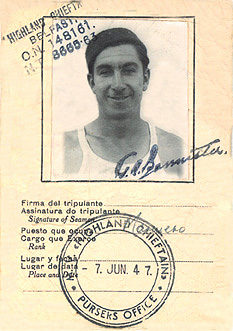
Charlie's
Landing Pass from a later visit
to
Argentina
|
After Port Stanley, we returned once more to Buenos Aires and
Rosario, Argentina,
where Veerhaven was loaded up with a cargo of
linseed destined
for the United Kingdom. Although, we didn't know it
at the time,
the linseed was to prove to be a fortunate choice. After
our holds were full, Veerhaven headed north for
the Caribbean island of Trinidad,
which was intended to be our
first stop on the way way home.
On November 10th, as we were proceeding northwards
about 800 miles off Recife, Brazil, our Radio Operator
received an
SOS
from an unidentified ship. The ship, which was
apparently somewhere ahead of us, reported
that she was being attacked by submarines. Our captain
suspected that the message was a trick designed to lure us into
a trap, so he ordered a change of course away from the
other ship's position.
The next day was November 11th -- Armistice Day -- and in the
early morning hours
I was awakened
suddenly by
the sound of heavy gunfire and machine gunfire.
I raced up on deck, but when I arrived
all I could see in the dark
were brilliant flashes coming towards the
port bow and
port beam
(the left front and side) of our ship. The flashes
were followed by explosions and fires
which broke out on the ship's deck.
We did not know until years later that we
were
being shelled
by the Italian submarine
Leonardo da Vinci
which was
under the command of the Italian ace,
Lieutenant Gianfranco Gazzana Priaroggia.
Da Vinci
had just recently arrived
in Brazilian waters with the intention of
attacking Allied merchantmen, which like us,
were travelling as independents, without naval escorts.
Beginning with the
SS Empire Zeal
which
Da Vinci sunk on November 2nd,
the submarine had also attacked the
SS Frans Hal
on November 3rd, the
SS Andreas
on November 4th, and the
SS Marcus Whitman
on November 8th. Only Frans Hal
had managed to escape her attacker -- Da Vinci
had shot five torpedoes
at the freighter, but fortunately they were all misses.
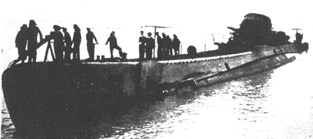
|
This photo shows the sub
Leonardo da Vinci
sometime in 1942.
Da Vinci sunk 17 Allied ships,
more any of the other Italian subs. Da Vinci's
main commander,
Gianfranco Gazzana-Priaroggia,
was the 2nd highest scoring Italian ace with a total of 11 ships,
10 of them while he was in command of the
da Vinci.
|
|
One of the Da Vinci's victims was the CPR passenger
liner
Empress of Canada. She
was torpedoed and sunk off the Gold Coast of Africa on March 14th,
1943
with the loss of nearly 400 lives, many of them
Italian POW's.
Gazzana-Priaroggia
and all his men died on May 23rd, 1943 when Da Vinci
was sunk north-east of the
Azores
by the destroyer
HMS Active
and the frigate HMS Ness.
|
|
This photo belonging
to David Woodward is from the 1989 edition of
Jane's Fighting Ships of WWII,
published by Bracken Books, London.
|
I was a member of Veerhaven's gun crew,
so once I had arrived on deck I attempted to clamber
up to the gun platform. But, it was impossible to
get up up there because the area was being raked by machine
gun bullets. Soon it became evident that
there was nothing we could do to save the Veerhaven,
and our captain gave the order to "abandon ship".
There were two lifeboats on either side of the ship and I
was assigned to the
captain's lifeboat on the starboard
(right) side.
As we lowered the boats and were getting in them, I heard a
very big bang which I thought might might
have been an explosion in the engine room. The force
of the explosion caused Veerhaven's funnel to
lift off the deck.
Our lifeboat had a small engine as well as a sail, and as soon
as we were all
settled, our captain ordered the engine started so that we could
pull away as quickly as possible. During all this
time Veerhaven was still being fired upon, and we were
lucky
that neither our boat nor anyone in it was hit.
When daylight came, we were all saddened when we realized
that the other
lifeboat which had been launched from the
port (left) side of the ship, was nowhere in sight.
The captain then ordered
our sail to be raised and we set off for the coast of Brazil,
hundreds of miles away.
That same day we saw an aeroplane, but there was no indication that
the plane saw our tiny little speck on the ocean. Another day passed
and then on November 13th shortly before sunset, we spotted
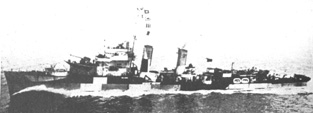
This WWII Brazilian destroyer is from the 1989 edition of
Jane's Fighting Ships of WWII published by
Bracken Books, London.
|
the welcome sight of a
Brazilian destroyer
heading towards us.
The vessel approached us with all guns manned because
in the half-dark, the crew thought that our mast might
well be the periscope of an enemy
submarine.
When the destroyer
got closer, her crew realized that we were survivors of
an Allied ship, and they soon had us all brought safely aboard.
We managed to communicate quite well with our rescuers
and they told us that they were out on a ten-day
trial of their new American-built ship. In fact, it was the very
last day before their return to port when they spotted us.
We realized that we were very, very fortunate.
Our rescuers took us to one of our earlier ports of call,
Natal, Brazil.
Natal's location on the easternmost
bulge of Brazil's coastline
had turned out to be
a great benefit to the Allies because it
provided the shortest air route
across the Atlantic to the coast of West Africa.
Before its entry into the war the USA had
acquired various stragetic bases throughout the
Atlantic Ocean including a string of southern
airfields at
Puerto Rico,
Trinidad,
British Guiana,
Belém, and
Natal.
By time we arrived at Natal
in November 1942, the
United States
Air Transport Command (ATC)
was keeping very busy ferrying
American-built bombers and transport planes
across the Atlantic
and onward to the
Allied forces
fighting in North Africa.
The amazing
ATC
air route eventually stretched as far
as Kumming,
China,
over 14,000 miles from its start in
Florida.
After just a few days in Natal, space was found for us aboard
a military DC-3 plane which was
heading back to the United States.
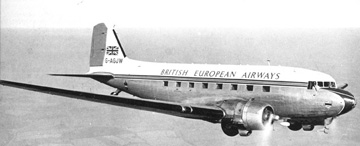
|
The DC-3 was a remarkable two- engined civilian aircraft which
was built in 1936 by the
Douglas Company of California.
The DC-3 was so superior to other aircraft of the time that
it soon became the number one choice of commercial
airlines around the world.
|
|
This photo of a post-war
DC-3 is from
The Encyclopedia of Aviation edited by Paul Beaver and
published by Gallery Books, NY, c1986, 1989 Octopus Books, London.
|
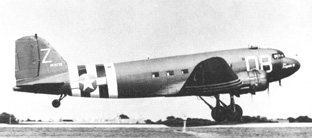
|
The military version of the DC-3 was the
C-47 transport
and it was just as successful
as its civilian counterpart.
The C-47 was known by a great variety of names including
Gooney Bird,
Dakota,
Dizzy-Three and
Skytrain.
|
|
This photo of an American
C-47 with D-Day invasion stripes
is from The World's Classic Aircraft by Mike Jerram,
published by Galahad Books, NY, c1981 Charles Herridge Ltd, London.
|
It was a lucky thing for us that the DC-3 had been
cleverly designed so that
it could fly on only one engine because as we flew over
the Brazilian jungle, one of our engines caught on fire.
However, the loss of the engine was not a problem and we
continued on to the American base on
the Caribbean island of
Puerto Rico where we landed
safely, appropriately enough on the American holiday of
Thanksgiving Day.
Our damaged engine was exchanged for a new one and three days after
landing at Puerto Rico we arrived at our destination of
Miami,
Florida. We caught a train which
took us up the American coast and deposited us 36 hours later
into the freezing cold weather of
New York city.
But, although the weather itself was bitterly cold,
I found that the people
there
were very warm and they made me feel very welcome.
I spent
a month in New York waiting for a ship and then signed on another
Dutch vessel, the SS Palembang.
On our way across the North Atlantic to the UK, we struck the
worst storm in fifty years. I was thrown about quite badly,
injuring both my knees and after we finally arrived in
Liverpool,
I had to spend some time in hospital recovering from my knee
injuries.
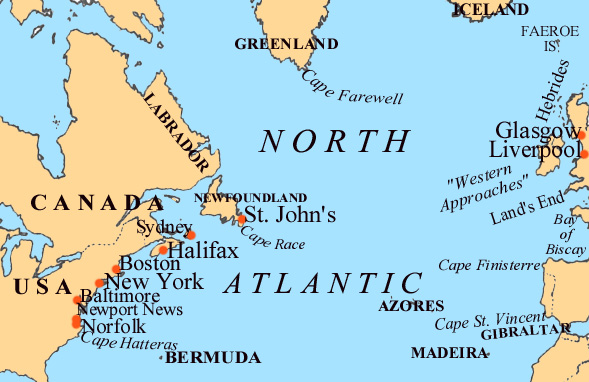
In May 1943 I signed aboard the
Dutch-flagged
SS Aelbert Cuyp
but I had to be taken off her at Hull, England and
hospitalized again with a bad bout of influenza.
When I was recovered
I sailed again in June 1943 aboard another Dutch ship, the
SS Jan Van Goyen. While
Jan Van Goyen was in
Boston,
Massachusetts, I had the
misfortune to fall down the hold. That landed me in
hospital for another 10 days, but I was lucky that
I only had a few bumps and bruises and nothing broken.
It was around this time I found out what had happened to
the men who had been in
Veerhaven's port lifeboat.
During Da Vinci's attack the lifeboat was badly damaged and
was in
such bad condition that it would not have gotten very far.
However, it was then that the signifigance of Veerhaven's
linseed cargo
became apparent.
Veerhaven had capsized, but she did
not sink right away because the
linseed swelled up in the water and
actually helped to seal some of the holes in her hull.
When the crew in the damaged lifeboat
realized that Veerhaven
was going to stay afloat, they
clambered up onto the upturned keel. There they
remained for three
days while they patched up the lifeboat as best they could.
Then they set
forth in the fixed-up boat and after five difficult days had the
good fortune to be picked
up by a tanker from the neutral
country of Uruguay.
By the time of the
Normandy Invasion which began on June 6th, 1944,
I was serving on my 9th and last ship, the
Dutch-flagged Philips Wouwerman.
As the Allies pushed north-eastwards across Europe,
it became essential that they acquire the port of
Antwerp,
Belgium in order to
resupply their troops. The city of Antwerp was
liberated on the
4th of September, 1944, but the port could not
be used by the Allies because the Germans still held
the seaward approaches to the city along the
Scheldt Estuary.
It wasn't
until early November, after a gruelling and costly
campaign, that the Allies
secured the Scheldt. Once Antwerp
was open to Allied shipping, Philips Wouwerman
was one of the merchantmen which became involved in keeping the
vital port supplied. Even though by this time in the war
the Allied victory seemed certain, the German forces
never let up and their efforts to
prevent
our merchant convoys from reaching Antwerp intensified.
Allied merchantmen
continued to be lost to enemy
mines,
E-boats, air-raids,
midget submarines and the new
harder-to-detect Schnorkel-equipped
U-boats,
right up to the end of the war.
In the German-occupied part of Holland the final winter of 1944-45 was
so hard on the Dutch people that
many of them starved
to death before the Netherlands could be liberated.
On April 28th, 1945, a
truce was arranged between the
advancing Canadian forces
and the Germans to allow food to be brought in to the Dutch
civilians. My last
wartime convoy was involved in this
humanitarian effort and we took vital food supplies
to the Dutch port of
Rotterdam. It was a fitting way for
a Dutch merchant ship to end the war.
|



